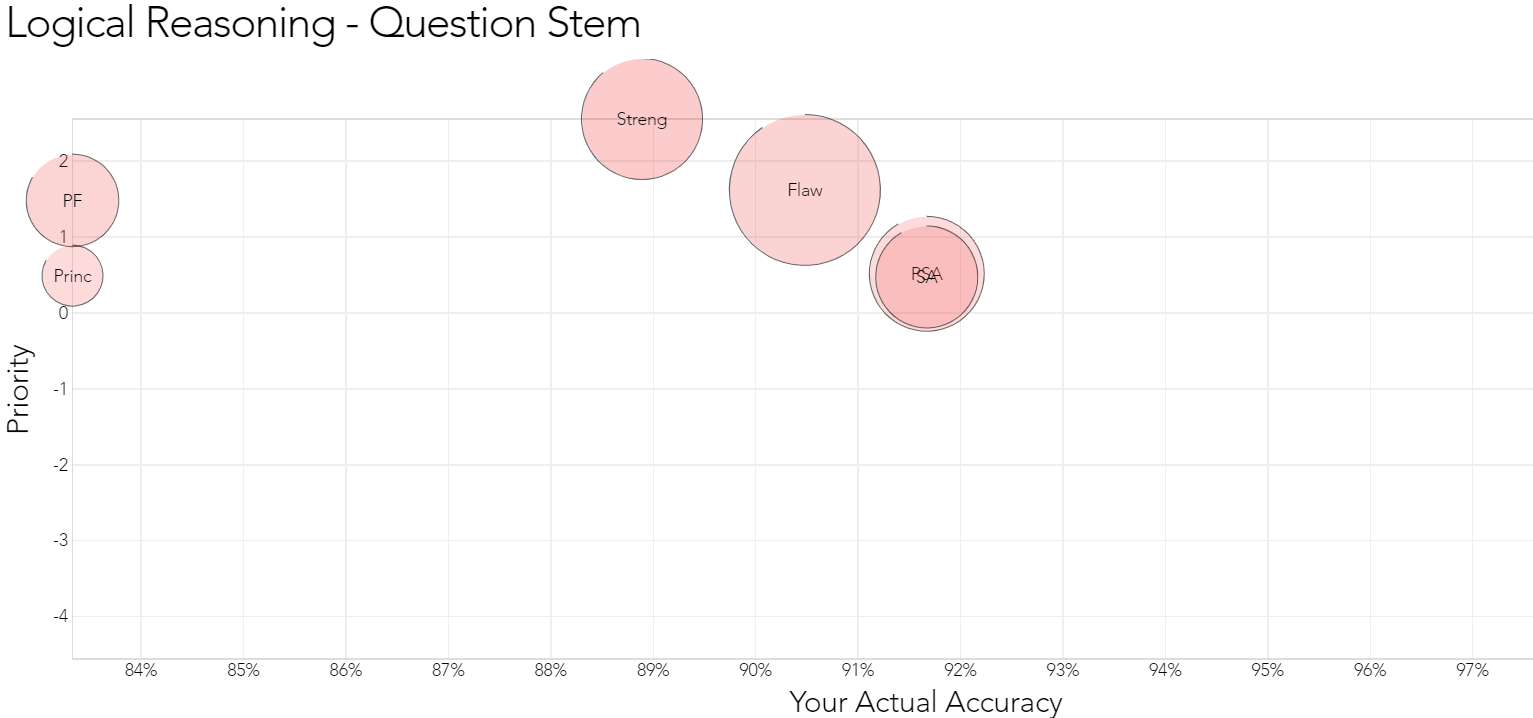If you are looking to push your LSAT score up from a 160 to a 170, here are some ways you can make that happen. But first of all, congrats on making it to 160! That’s no small feat!
[And if you aren’t yet up to the 160, or perhaps even feel like that’s a long way off, my hope is that you’ll still be able to get a lot out of this post. The logic here is that what will push a student from 130 to 140 on the LSAT might not be enough to push a student from 160 to 170, but what will push someone into the 170s will also benefit the students lower on the scoring scale. I’ll address this post to a student in the low 160s, but translate it to your own situation regardless of where you’re at.]
How you got to 160
When you first started studying for the LSAT, you probably (hopefully!) worked on foundational skills. Understanding arguments. Learning how to diagram the games. Memorizing question types and lists of flaws. And drilling your areas of weakness.
But when you’re trying to get from a 160 to a 170 on the LSAT, you’ll need something different. What got you to where you are now probably won’t get you the rest of the way. It’s probably not going to be as simple as identifying what is coming up most often in your mistakes and reading chapters from Powerscore or the LSAT Trainer to learn how to approach those questions. You likely know that content at this point.
The components of your new study plan
If you haven’t already, it’s time to shift your study plan so that it includes these pillars of a robust study regimen:
- Drilling
- Timed practice
- Future-focused review
The most important of these is the future-focused review. So let’s knock out a discussion of the first two so that we can spend the rest of this post diving into what that future-focused review should look like.
Drilling
In the low 160s, you probably still have a few well-defined areas of weakness. Based on your recent practice tests, figure out what those are.
One way to do this is to create a free account on 7sage, then input your answers from practice tests into their system. If you then go into Analytics, you can pull up some very informative summaries of your performance on the tests. (You may need to translate some of 7sage’s question type or game type terminology into the terminology you are more familiar with. Here’s a resource that may help with that.)
Once you’ve identified these areas of weakness, you can drill questions to address them. LSAT Demon is a great drilling resource that might help here, but you can create your own drill sets with just a Lawhub subscription as well.
To find LR questions of a certain type
To find games sorted by type or here or here
For RC, every test has a law passage, a science passage, and a humanities passage. Every test after 2007 has a comparative passage. So pretty much just pick a practice test and use whichever passage type you need to drill.
Drilling can help you get out of the low 160s. It won’t get you all the way to 170, but it will be an essential step to making sure that you take advantage of any low-hanging fruit. The closer you get to 170 (and beyond), the less you’ll be able to make progress through drilling and sheer repetition.
Timed practice
Once you feel like you’ve made measurable progress on one of your areas of weakness through drilling, it’s time to put that to the test by doing some timed practice. You should sometimes do just a timed section to get more immediate feedback about whether you are making the progress you think you are. But you also need to do timed full-length tests to make sure you’re also building the necessary stamina to be able to maintain intense focus throughout the entire exam.
Once you’re getting close to the 170 mark, try doing some timed practice using particularly difficult practice test sections. (Use these sections as a learning opportunity, and don’t be too hard on yourself if you do this. Keep in mind that the curve for a more difficult test will also be more forgiving. That’s the standardized part of a standardized test.)
Warning!
Don’t overdo it with the timed practice, even at this stage. Remember that the purpose of timed practice is to check how you are doing. It’s about assessing where you are at. So taking them repeatedly, without doing anything else, is just measuring yourself repeatedly. It’s like trying to lose weight by jumping on the scale all the time. I mean, I suppose you’ll get a little exercise from all that jumping, but that’s not what’s going to drive most of your weight loss.
So if timed tests are about assessing your progress, then what actually pushes you forward?
Having solid review habits does. Which is why this next section about future-focused review is so incredibly important.
Future-focused review
Up to now, you might be accustomed to reviewing by checking your answers, reading through an explanation you find online, and maybe redoing some of the games if you feel that you need to.
You may have heard of blind review, and maybe you have been doing that. (Blind review is essentially resolving questions you weren’t sure about to see if you can get them right without time pressure.)
But chances are you can deepen the review you are doing and therefore get more out of the review. And this is really what is going to push you from 160 to 170 on the LSAT.
Reviewing questions you got right as well as the questions you got wrong. Even if you got a question right, you may have been unsure or you may have gotten it right for the wrong reason. There’s usually something more you can learn from a question. Figure out what that is.
Make sure you study the questions until you really understand the reasoning. It should have a feeling of “clicking into place” when you finally figure it out. If you’re at the stage of “I see why it’s C, but B still sounds good too” then you’re not done yet.
This might sound like an aggressive, intense way to review, and it is. But it’s not easy to break 170 on the LSAT, so you need an aggressive method.
What future-focused review looks like
Here’s where a lot of advice about review on the LSAT falls short. It’s easy to get caught up in looking back at the questions, seeing where you went wrong and thinking about what you should have done instead.
But it’s equally important (or more important!) to make sure you are also looking forward. Your review isn’t worth much if it’s not going to impact what you do next time you do a timed practice test section.
The easiest way to make your review future-focused is to ask yourself what’s the one thing you can take away from this question to apply to future questions.
Try to drill down into why you missed a question. Get more precise than “I didn’t understand the stimulus” or “I didn’t read carefully.”
Did you miss that LR question because you didn’t notice the subtle shift in wording? Because you didn’t initially see how the correct answer was relevant to the stimulus? Or because you didn’t diagram some of the formal logic? Or because you were putting too much of your focus on one little thing in the stimulus instead of what actually mattered?
Once you find this reason, turn it into a takeaway. If you missed the question because you didn’t notice the shift in wording, then your takeaway should be to pay attention to the exact phraseology used in the stimulus so that you can check for shifts.
At the end of your review session, look back over your list of takeaways. Did anything show up on your list pretty often? Which ones are the most important? Figure out what you should apply to future questions and put systems into place so that you won’t miss those future questions. Write them on post-its and have them handy next time you practice.
(If you want a guide to help you with future-focused review, check out my LSAT Practice Test Review Guide.)
Future-focused review tips by section
Here are a few specific things to consider in each section when you review to help push your LSAT score from 160 to 170.
Logic Games
- Are you making mistakes in the rules or in the questions? These mistakes can be subtle sometimes!
- Do you ever forget about a rule? If so, what can you do to make the rule more obvious?
- Is your diagramming clear and consistent?
- Are you using your previous work effectively? Are you doing the questions in the most effective order so that you can capitalize on previous work?
- Do you have a good process for the rule substitution questions?
Logical Reasoning
- Do you always know what question type you are dealing with and exactly how to deal with it?
- What are the little words/connections/subtle shifts you sometimes don’t notice in the argument?
- Do answers sometimes seem irrelevant even if it actually turns out to be relevant (or vice versa)? What is keeping you back from understanding the true scope of the argument?
- Do you diagram when it’s helpful to do so? And do you ever make mistakes in your formal logic?
- Do you go into your answer choices with a clear idea of what to expect?
Reading Comprehension
- When reading, do you need to be paying more attention to the structure of the passage? To viewpoints?
- Do you find specific support for all of your answers?
- Are you tempted by answers that start off ok but go off track later on?
- Do you have a plan of attack for the questions that ask simply “Which of these things is in the passage?”
Overall
- How are your focus and stamina?
- Are you pacing yourself appropriately?
- Are you able to get yourself back on track if your focus fades or your confidence falters?
Final Thoughts
The journey from 160 to 170 on the LSAT can be a long, difficult one. It’s not going to come through quick wins, and it’s going to require a significant mental investment. But that doesn’t mean it’s impossible.
The best thing you can do for yourself as you enter this new stage of your LSAT prep is to recognize that you’ll need to shift your focus away from learning question types, diagramming methods, and step-by-step strategies. Instead, you’ll need to focus more on identifying exactly what’s holding your reasoning back and where exactly you’re not seeing the things you should be in the questions. Hold yourself to a high standard, don’t skimp on your review, and keep asking yourself what, specifically, you can learn from each question you do.
LSAT Notes
If this post resonated with you, I’d love to stay in touch. About once a week, in the form of an email newsletter, I share useful strategies and insights I’ve picked up during my years teaching the LSAT. “LSAT Notes” you can use to study more effectively and raise your score.
Often these are inspired by breakthroughs my students had that week. Other times, they respond to questions students like you have. My goal is to provide motivation and encouragement along with knowledge about the test and advice about how to study.
Learn more about it here, or to subscribe, simply fill in the form below.


